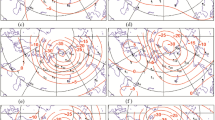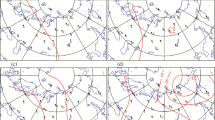Abstract
The review is based on the results of the operation of the total ozone (TO) monitoring over the CIS and Baltic countries that functions in the operational mode at the Central Aerological Observatory (CAO). The monitoring system uses data from the national network equipped with M-124 filter ozonometers, which is under the methodological supervision of the Main Geophysical Observatory. The quality of the functioning of the entire system is operationally controlled at CAO by the comparison with the OMI satellite equipment observations (NASA, USA). Basic TO observation data are generalized for each month of the second quarter of 2020 and for the second quarter. Data of routine observations of surface ozone values in the Moscow region are also considered.




Similar content being viewed by others
REFERENCES
A. M. Zvyagintsev, N. S. Ivanova, G. Kakadzhanova, G. M. Kruchenitskii, and I. N. Kuznetsova, “Ozone Content over the Russian Federation in the Second Quarter of 2008,” Meteorol. Gidrol., No. 8 (2008) [Russ. Meteorol. Hydrol., No. 8, 33 (2008)].
A. M. Zvyagintsev, N. S. Ivanova, G. M. Kruchenitskii, L. B. Anan’ev, and M. I. Nakhaev, “Ozone Content over the Russian Federation in the First Quarter of 2011,” Meteorol. Gidrol., No. 6 (2011) [Russ. Meteorol. Hydrol., No. 6, 36 (2011)].
A. M. Zvyagintsev, I. N. Kuznetsova, I. Yu. Shalygina, E. A. Lezina, V. A. Lapchenko, M. P. Nikiforova, and V. I. Demin, “Investigation and Monitoring of Surface Ozone in Russia,” Trudy Gidromettsentra Rossii, No. 365 (2017) [in Russian].
N. S. Ivanova, Methods for Total Ozone and UV Index Forecasting (2010); http://method.meteorf.ru/methods/pollut/uv/uv.html [in Russian].
N. S. Ivanova, “An Empirical Model of Ultraviolet Index Calculation,” Trudy Gidromettsentra Rossii, No. 365 (2017) [in Russian].
N. S. Ivanova, G. M. Kruchenitskii, I. N. Kuznetsova, V. I. Demin, and V. A. Lapchenko, “Ozone Content over the Russian Federation in the First Quarter of 2020,” Meteorol. Gidrol., No. 6 (2020) [Russ. Meteorol. Hydrol., No. 6, 45 (2020)].
N. S. Ivanova, G. M. Kruchenitskii, I. N. Kuznetsova, V. A. Lapchenko, and V. V. Shirotov, “Ozone Content over the Russian Federation in the Second Quarter of 2019,” Meteorol. Gidrol., No. 9 (2019) [Russ. Meteorol. Hydrol., No. 9, 44 (2019)].
Air Quality Guidelines: Global Update 2005—Particulate Matter, Ozone, Nitrogen Dioxide and Sulphur Dioxide (World Health Organization, Geneva, 2006).
J. G. Anderson, W. H. Brune, S. A. Lloyd, D. W. Toohey, S. P Sander, W. L. Starr, M. Loewenstein, and J. R. Podolske, “Kinetics of O3 Destruction by ClO and BrO within the Antarctic Vortex: An Analysis Based on Situ ER-2 Data,” J. Geophys. Res., 94 (1989).
Author information
Authors and Affiliations
Corresponding author
Additional information
Russian Text ©The Author(s), 2020, published in Meteorologiya i Gidrologiya, 2020, No. 8, pp. 138-143.
About this article
Cite this article
Ivanova, N.S., Kruchenitskii, G.M., Kuznetsova, I.N. et al. Ozone Content over the Russian Federation in the Second Quarter of 2020 . Russ. Meteorol. Hydrol. 45, 599–605 (2020). https://doi.org/10.3103/S1068373920080117
Received:
Revised:
Accepted:
Published:
Issue Date:
DOI: https://doi.org/10.3103/S1068373920080117




